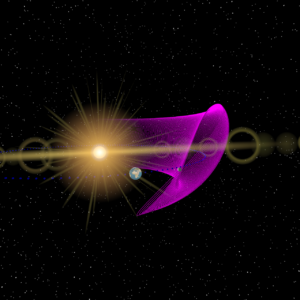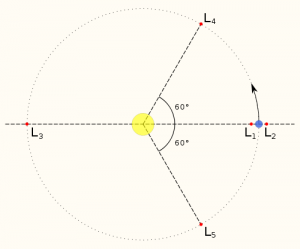
It just doesn’t get any bigger than this: today a discovery by Canadian researchers is gracing the cover of Nature magazine. It is not an understatement to say that this is the science equivalent of getting your picture on the cover of the Rolling Stone, and I do sincerely hope Martin Connors, Paul Wiegert and their French colleague Chistian Veillet are enjoying their moment in the international spotlight.
So, what’s precipitated this moment of mass adulation and fame? An asteroid. Its name is a bit of a mouthful, 2010 TK7, which according to my limited understanding of the vagaries of the provisional naming system, means it was first discovered in early October of 2010, and that it was the 185th new object to be discovered in that two-week period. But what’s made it so famous is that it seems to be the first example of a Trojan companion for the Earth.
To explain what a Trojan companion is, we have to go back to 1772, when the French mathematician and astronomer Joseph-Louis Lagrange first worked out the locations of his eponymous points. The gist of the theory is that in a system where a planet is orbiting a sun, small bodies (like asteroids) get kicked around quite a bit by the gravity of the two larger bodies. Because of this, they tend not to stick around very long; they either get ejected from the system or crash into something. What Lagrange showed was that there is a third option: if the asteroid orbits in just the right spot – a Lagrangian point – the gravitational forces of the larger bodies balance each other out. The result is an asteroid that, from the vantage point of the planet, appears to remain in roughly the same spot, give or take a few million kilometers.

Each planet has five Lagrangian points, but they are quite different in quality. L1 to L3 can be likened to the situation of a ball balanced on top of a hill; technically all the forces are in balance, but if a slight breeze comes along it will fall off. L4 and L5 are more like a ball at the bottom of a punch bowl; it won’t move, and if disturbed it will tend to fall back to where it was. It took until 1906 for scientists to find the first asteroids caught in Jupiter’s L4 and L5 points. At the time, the classically-minded astronomers started naming the L4 asteroids after the heroes of the mythical Trojan war (the L5 ones were named after the heroes of the Greek side, although there’s at least one mixup.)
Jupiter has literally thousands of Trojans. So do Mars and Neptune. It was almost certain that Earth had them too, but finding them has been almost impossible. This is due to a problem of perspective; because of where the L4 and L5 points lie on our orbit, they always appear quite close to the sun. This means that we can only scan them during the day, when the glare is too bright to see anything.
Martin Connors has spent decades looking for Trojans, and last year he finally got a break when he was allowed to access data from NASA’s Wide-field Infrared Survey Explorer (WISE), a space telescope launched in 2009. By scanning the entire sky in the infrared spectrum, WISE found over 155,000 asteroids, including 132 previously unknown, near-Earth bodies. 2010 TK7 is one of these, and its status as a Trojan was confirmed with independent observations from the Canada-France-Hawaii Telescope.
The asteroid is not likely to be different in terms of composition from the thousands of others like it throughout the solar system. It’s distinguishing characteristic seems to have been its wonky orbit, which is part of the reason it was easier to find than others that may still be lurking out there. In the following animation you can see the path it traces, referred to as a ‘tadpole orbit,’ although to me it looks more like a ball caught in a punch bowl, as I explained above.
For all the attention they’ve received, Trojans companions don’t seem to be particularly practical. Although there has been some talk of using them as convenient waystations on the way to other planets, we’re likely decades away from needing them for that purpose. Instead, they are a novelty, a reminder that space isn’t as empty as we often think it to be. And the fact that 2010 TK7 was found by Canadians is something we can be proud of. Way to go, eh?
No comment yet, add your voice below!